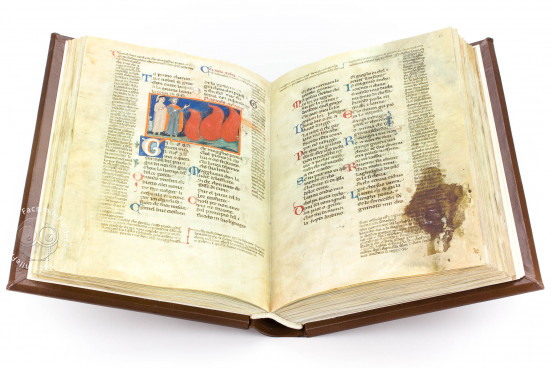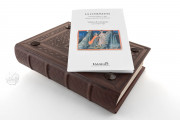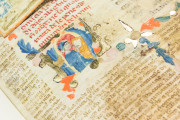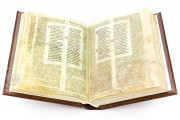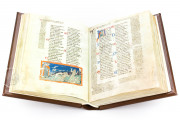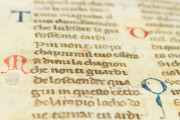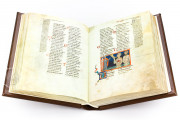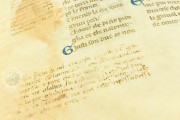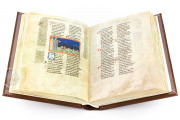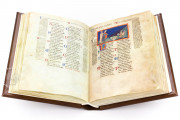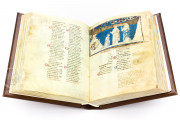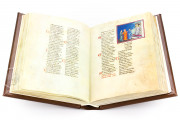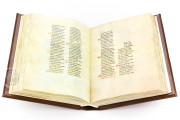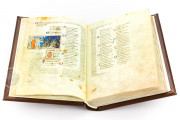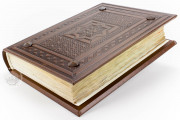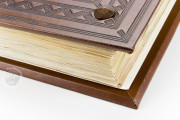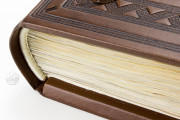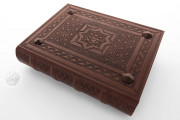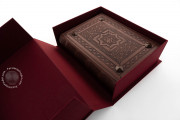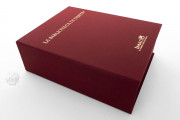The Palat. 313 Manuscript of the Divine Comedy by Dante Alighieri is one of the earliest illuminated manuscripts of the poet's long Christian moralizing poem. It was created in Florence in the second quarter of the fourteenth century, with the copying perhaps underway before 1333. A series of textual additions was made around 1400. The manuscript boasts thirty-seven miniatures painted by artists working in the tradition of the Florentine masters Pacino di Bonaguida, Giotto, and Bernardo Daddi.
The poem describes Dante's journey through the otherworld, led first by the ancient Roman poet Virgil (70-19 BCE), then by Beatrice (a character from one of the poet's earlier works), and finally by Saint Bernard of Clairvaux (d. 1153). His pilgrimage is identified as having taken place in 1300 and takes him through circles of hell (in Inferno), terraces where souls purge themselves (in Purgatorio), and heavenly spheres (in Paradiso).
Inventing New Pictures
The Palatine codex is a pioneering work, the earliest surviving—and probably the first ever—manuscript in which the poem's narrative is traced in pictures. It is a splendid witness to the work of artists creating new subjects.
Dante's text freely weaves historical and mythological figures into the imaged atmosphere of the underworld. The formulaic quality of the illustrations to Inferno—with Dante and Virgil pictured at the left observing the punishments of sinners at the right against a deep blue background—betrays their invention for this manuscript.
More telling are the representations of characters from ancient mythology, which draw on early illuminated manuscripts of ancient literary texts. Among these are: Charon, the ferryman of the ancient Greek underworld (fol. 6v); Minos, King of Crete (fol. 11v); the multi-headed Cerberus (fol. 14r); and the man-bull Minotaur (fol. 28r).
A Big Undertaking
The ambitiousness of the enterprise meant that the illumination of the book was left unfinished. Thirty-two of the manuscript's thirty-seven finished miniatures illustrate the poem's first canticle, Inferno. Blank spaces were left for miniatures in much of the book.
Layout of a Scholarly Text
Dante's poem is presented in the center of the book's pages in two columns so narrow that each poetic verse occupies multiple lines and ample space remains on the page for commentary. This layout constitutes a statement about the perceived value of the text, placing it on a level with Latin scholarly texts of the period.
Who Is JA?
The commentary, written in a smaller script, occupies the generous margins around the text, testifying to the belief that the poem required explanation and deserved serious study. The initials JA appear frequently in the commentary. These indicate their source in the work of Jacopo Alighieri, the poet's son.
Key Monument for the Historiography of the Text
The manuscript was in the possession of the Florentine bibliophile Piero Del Nero in the sixteenth century and then the Guadagni family before being purchased in 1800 by Gaetano Poggiali (1753-1814), who consulted it in preparing his edition of the Commedia. The manuscript's resultant fame has led to the nickname Codice Poggiali.
We have 1 facsimile edition of the manuscript "Divine Comedy - Palat. 313 Manuscript": Palatino 313 - La Commedia di Dante Alighieri facsimile edition, published by Imago, 2012
Request Info / Price
